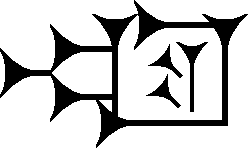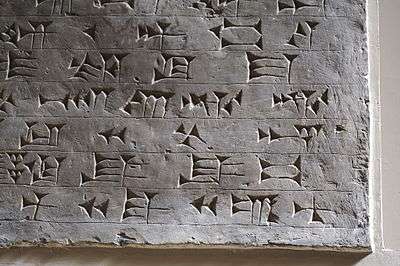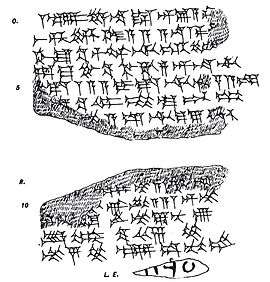Ud (cuneiform)
The cuneiform ud sign, also ut, and with numerous other syllabic uses, as well as multiple sumerogramic uses is a common sign for the mid 14th-century BC Amarna letters and the Epic of Gilgamesh. The sign is constructed upon the single vertical stroke
| Look up 𒌓 in Wiktionary, the free dictionary. |


Sign ut/ud, last sign in line 1.
Line 1: im, u, an, ṣur-(or =AMAR), and ud.
(high resolution expandible photo)
| Wikimedia Commons has media related to Ud (cuneiform). |
| Wikimedia Commons has media related to Cuneiform signs, Amarna letters. |
In the Epic of Gilgamesh, sign ud is listed as used for the following linguistic elements:[1]
- lah
- par
- pir
- tam
- tú
- ud
- ut
- uṭ
Sumerograms
- BABBAR--"silver"
- UD--"daily", "day", (2nd "daily"-(no. 2))
- UTU--"sun"
The usage numbers for each linguistic element in the Epic of Gilgamesh are as follows:[2] lah--(2), par--(5), pir--(4), tam--(32), tú--(46), ud--(30), ut--(95), uṭ-(7), BABBAR-(1), UD-(75), UTU-(58).
Amarna letters usage
In the Amarna letters, mid 1300's BC, letters written to the King (Pharaoh) of Egypt (or an official at the Egyptian court), many letters (numbered up to EA 382, about 300+ actual letters, or partials) are written by 'governors' of city-states in Canaan.

The Canaanite letters are famous for various forms of a prostration formula, following a 'letter Introduction'. The introduction often states accolades such as: "...(of) My-God(s), My Sun-God,....", or continuing, "My Sun, from, Heaven"-(heaven),sa-me. (Akkadian language: anUTU-ia ANUTU-Sa-Me, English: God-Sun-mine, Heaven-Sun-"Sa-Me", for Akkadian heaven, "šamû".[3]) "Sun" is here used as UTU. Numerous Canaanite letters use this; other letters, for example Amarna letter EA 34[4] titled: The Pharaoh's Reproach Answered, addresses the Pharaoh as being honored "daily", referring to Sun God Ra's daily appearance–as "the sun" itself; Akkadian language 'daily', is "ūmussu",[5] and EA 34 uses UD (day, daily), ud-mi.
References
- Parpola, 197l. The Standard Babylonian Epic of Gilgamesh, Sign List, pp. 155-165, Sign No. 381, p. 162.
- Parpola, 197l. The Standard Babylonian Epic of Gilgamesh, Sign List, pp. 155-165, Sign No. 381, p. 162.
- Parpola, 197l. The Standard Babylonian Epic of Gilgamesh, Glossary, pp. 119-145, šamû, p. 140.
- Moran, William L. 1987, 1992, The Amarna Letters, letter EA 34, The Pharaoh's Reproach Answered, pp. 105-107.
- Parpola, 197l. The Standard Babylonian Epic of Gilgamesh, Glossary, pp. 119-145, ūmussu, p. 144.
- Moran, William L. 1987, 1992. The Amarna Letters. Johns Hopkins University Press, 1987, 1992. 393 pages.(softcover, ISBN 0-8018-6715-0)
- Parpola, 197l. The Standard Babylonian Epic of Gilgamesh, Parpola, Simo, Neo-Assyrian Text Corpus Project, c 1997, Tablet I thru Tablet XII, Index of Names, Sign List, and Glossary-(pp. 119–145), 165 pages.
|
|
